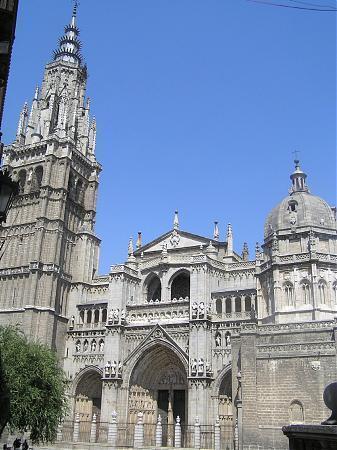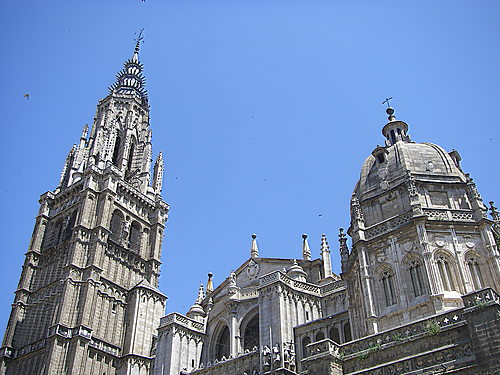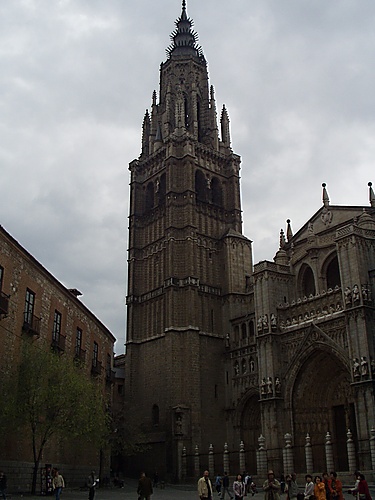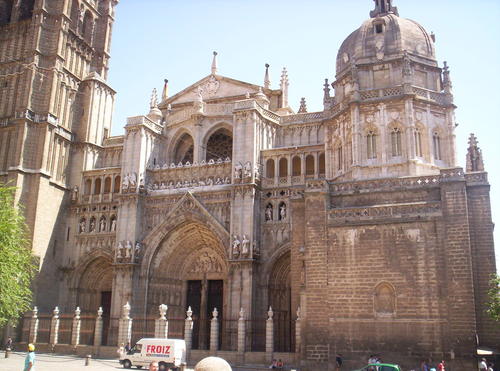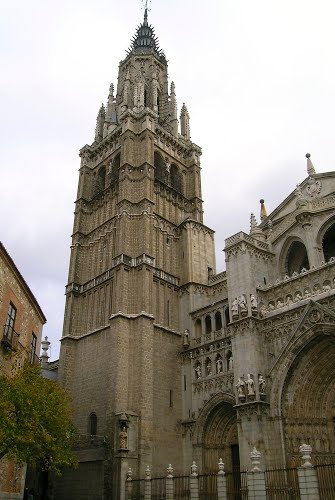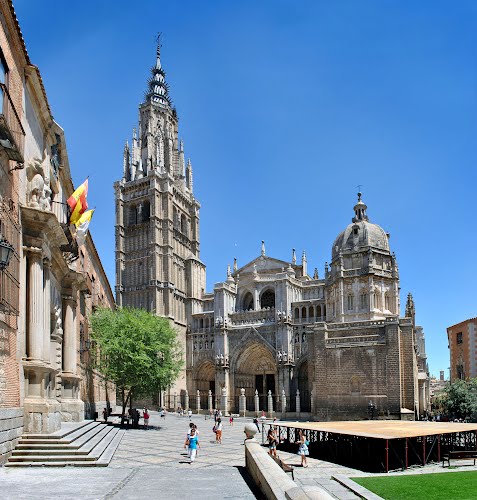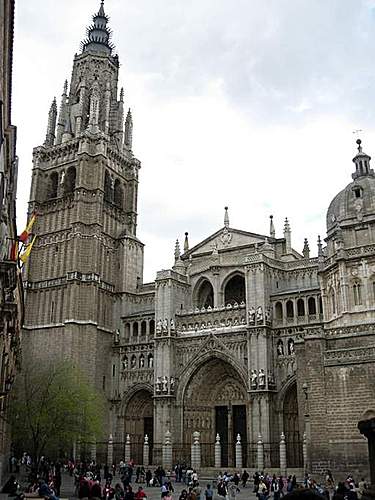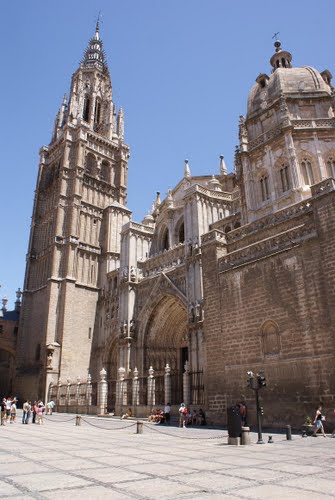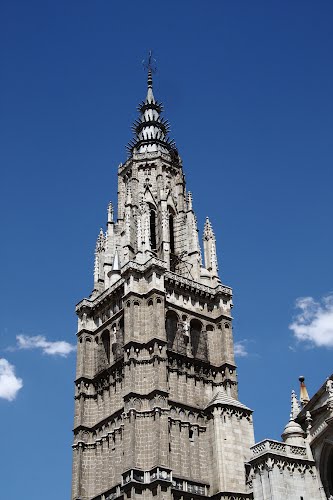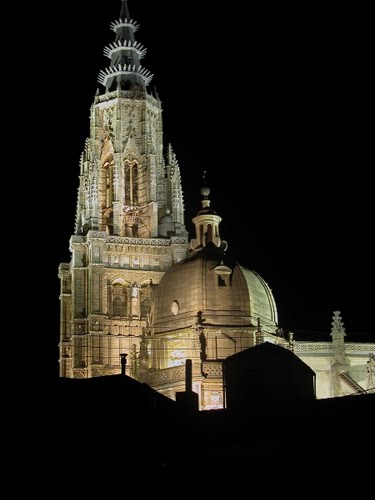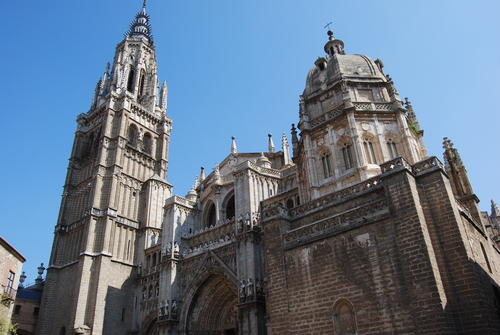The Primate Cathedral of Saint Mary of Toledo is a Roman Catholic cathedral in Toledo, Spain. It is the seat of the Metropolitan Archdiocese of Toledo.
The cathedral of Toledo is one of the three 13th-century High Gothic cathedrals in Spain and is considered, in the opinion of some authorities, to be the magnum opus of the Gothic style in Spain. It was begun in 1226 under the rule of Ferdinand III and the last Gothic contributions were made in the 15th century when, in 1493, the vaults of the central nave were finished during the time of the Catholic Monarchs. It was modeled after the Bourges Cathedral, although its five naves plan is a consequence of the constructors' intention to cover all of the sacred space of the former city mosque with the cathedral, and of the former sahn with the cloister. It also combines some characteristics of the Mudejar style, mainly in the cloister, with the presence of multifoiled arches in the triforium. The spectacular incorporation of light and the structural achievements of the ambulatory vaults are some of its more remarkable aspects. It is built with white limestone from the quarries of Olihuelas, near Toledo.
It is popularly known as Dives Toletana.
History
Origins
For many years, an unwritten popular tradition has held that there was originally a church from the era of the first Archbishop Eugene located in the same place as the present cathedral. This church was consecrated for a second time in the year 587, after having undergone some alterations.
The city had been the episcopal seat of Visigothic Spain. The numerous Councils of Toledo attest to its important ecclesiastical past. Also, the abjuration of Arianism on the part of Reccared occurred there. The Muslim invasion did not immediately eliminate the Christian presence and the bishopric remained established in the church of Saint Mary of Alfizen.
The Visigothic church was torn down and the main mosque of the city of Toledo was erected in its place. Some investigators point out that the prayer hall of the mosque corresponds with the layout of the five naves of the current cathedral, the sahn would coincide with part of the current cloister and the chapel of Saint Peter and the minaret with the belltower. Using certain archeological data it is possible to discern an Islamic column mounted inside the chapel of Saint Lucy, the marble shafts that decorate the exterior of the choir are an improvement of an old Muslim construction, and the intertwined arches of caliphate style in the triforium of the main chapel and of the ambulatory coincide with the Muslim construction tradition of Cordova.
The Cathedral of Alfonso V
The city of Toledo was reconquered by Alfonso VI, King of Leon and Castile, in 1085. One of the points of the Muslim capitulation that made possible the transfer of the city without bloodshed was the king's promise to conserve and respect their institutions of higher learning, as well as the customs and religion of the Muslim population which had coexisted with the larger Mozarabic population. Naturally, the preservation of the main mosque was integral to this compromise. Shortly thereafter, the king had to depart on matters of state, leaving the city in charge of his wife Constance and the abbot of the monastery of Sahagún, Bernard of Sedirac, who had been elevated to the rank of archbishop of Toledo. These two, in mutual accord and taking advantage of the absence of the king, undertook an unfortunate action which, as told by the priest Mariana in his General History of Spain, almost provoked a Muslim uprising and consequent ruin of the recently conquered city.
On 25 October 1087, the archbishop in cooperation with Queen Constance sent an armed contingent to seize the mosque by force. They proceeded to install a provisional altar and hung a bell in the minaret, following Christian custom to 'cast out the filthiness of the law of Mohammed'. The priest Mariana writes that king Alfonso VI was so irritated by these events that neither the archbishop nor the queen were able to prevent him from ordering the execution of all the active participants. Legend tells that the local Muslim populace itself helped restore peace, with its chief negotiator, faqih Abu Walid, requesting the king to show mercy, and imploring his fellow townsmen to accept the Christian usurpation as legitimate. In gratitude for this gesture, the Cathedral Chapter dedicated a homage to Walid and ordered his effigy to be placed on one of the pillars in the main chapel, in this way perpetuating his memory. Thus the conversion of the Toledan mosque was upheld and it remained consecrated as a Christian cathedral.
The building plans of the former mosque have not been preserved nor is the appearance of the structure known, but taking into account the preserved vestiges of mosques in other Spanish cities, it may be supposed that it was a columnary building, with horseshoe arcades on top of columns in revision of earlier Roman and Visigothic construction. It is possible that it appeared very much like the Church of the Savior of Toledo, previously a mosque.
King Alfonso VI made important donations to the new church. On 18 December 1086, the cathedral was placed under the advocacy of Maria and it was granted villas, hamlets, mills and one third of the revenues of all the rest of the churches of the city.
Pope Urban II recognised this church in 1088 as the primate cathedral over the rest of the kingdom. The mosque-cathedral remained intact until the 13th century, when in the year 1222 a Papal bull issued by the Pope authorised the construction of a new cathedral which was begun in 1224. The official ceremony of the laying of the foundation stone took place in 1226, with the presence of King Ferdinand the Saint. Throughout the 13th century the cathedral's income tax was raised through the previous incorporation of Alcala de Henares into its archiepiscopal territories in 1129.
The Cathedral of the Archbishop Ximenez de Rada
The layout of the cathedral as now seen was set in the 13th century, while Rodrigo Ximénez de Rada was archbishop of Toledo and during the reign of a young Ferdinand III of Castile. Commencement of the work was delayed until the king could be present at the official ceremonial cornerstone-laying (1227). Ximenez de Rada was elected bishop of Toledo in 1209, and thenceforth he defended the primacy of the Toledan See before the Papal authority. He aimed to build a grand cathedral, worthy of the city he governed. When he came to office, the mosque-cathedral had ample space, but with a low roof, making the interior noisy. The cathedral was aged; some sections had been demolished by his predecessor, and the structure lacked the slenderness and height of other religious edifices of similar importance. Ximenez de Rada became the enthusiastic promoter for a new cathedral, to be built in contemporary Gothic style. He was so enthusiastic about the project and involved himself so much in it that it was later falsely rumoured that he was the designer-architect of the cathedral. The archbishop spent a few years maintaining and reinforcing the old structure in hopes that his dream would be realised.

